
YOUR WINE TOUR ADVENTURE STARTS HERE


The other night, as I sipped on a satisfyingly crisp Birichino Vin Gris, I wondered about the type of grapes that go into making Rosé, which led me to ponder how grapes transform from fruit to wine. And although I know more on the topic than the average person, I realized that my curiosity exceeds my knowledge when an image of Lucy stomping grapes was the main thought coming to mind.
Know what? People still do that! But when they do, they are more likely to become an internet meme (a la “The Grape Lady”) than to produce a drinkable beverage.
OK, so, we’re all clear on the concept that wine comes from grapes. Here’s the tricky bit. It’s not as clear cut as ‘red wine comes from red grapes and white wine comes from white grapes and blush wine comes from blush grapes.’ There’s more to the process - and there are no blush grapes. And there are a million different decisions along the way that affect the end product.
Prior to harvest, the decision making is well under way. Choices related to vineyard location, vine selection, vineyard layout, watering, fertilizing, pruning, and many other factors all work together to produce fruit that varies in flavor and complexity based on all the decisions a viticulturist makes.
During harvest, still more decisions are impactful. First, obviously, the grapes have to be picked. When to pick them is crucial. The winemaker samples ripening fruit and tests key indicators like sugar content (measured in Brix) to determine the exact moment to collect the crop.
Picking is either done by hand or by machine, and even the method used to harvest impacts wine. A competent vineyard team can hand select the ideal bunches to develop the flavor profile desired by the winemaker.
And grapes are always picked by the bunch. Which means that stems and leaves come along for the ride. And seeds too.
So, the bunches have to be destemmed, but stems can impart some extra tannins and flavors to wine. So in some cases, they’re left attached for the next bit.
During the de-stemming process, the grapes are lightly crushed which gives the juice a chance to absorb color, flavor and tannins from the skin, seeds, and any stems that are still present. This was a critical moment for my Rose. You see, the length of time the juice and skins stay in contact determines the color the wine will have. The actual juice - even within the reddest varietals - is fairly colorless.
And yes, traditionally, grape crushing was done by stomping. Mmmm... toe wine. But nowadays, crushing is done by machine.
The list of decisions goes on and on. Naturally occuring yeast or a specifically selected strain? Oak barrels or stainless steel tanks... Or concrete amphoras? Single varietal or blend? Bottle fermentation (resulting in sparkling wine, aka Champagne)? Carbonic maceration (common in Beaujolais)? Malolactic fermentation (how a buttery Chardonnay gets its butteryness)?
The takeaway is that making wine is really complex and involves a lot of different and consequential steps. When Lucy finishes her grape dance, it’s not nearly over! There are still a “bunch” (not a lame pun, just the best word) of decisions that determine how the wine will look and taste.
Wait, does that answer our Rosé question? Yeah it does, right? To get Rosé wine, you leave the juice in contact with the skins just a little. Or, alternatively, you mix white wine with just a bit of red wine. It’s just another decision vintners have to make. Good thing they get to decompress with a gratifying glass of their intoxicating creation when the decision making is done.
~ Kay Syrah
Wine Country Guru Gal
Official Blog